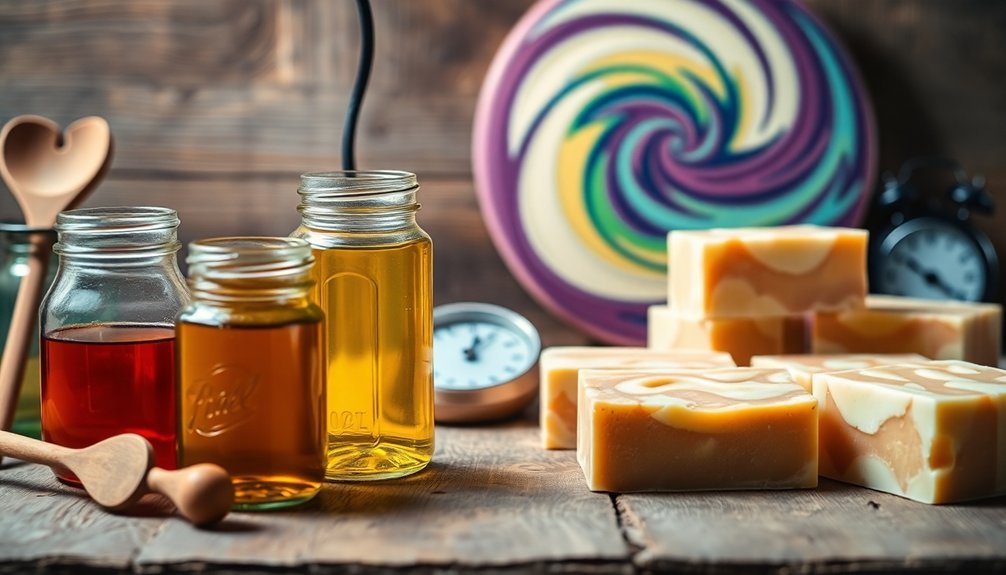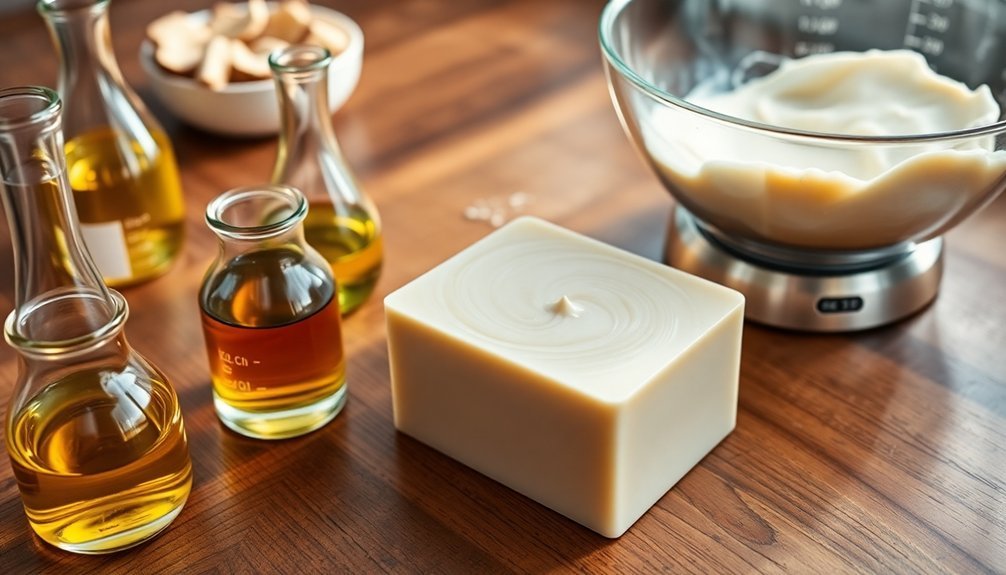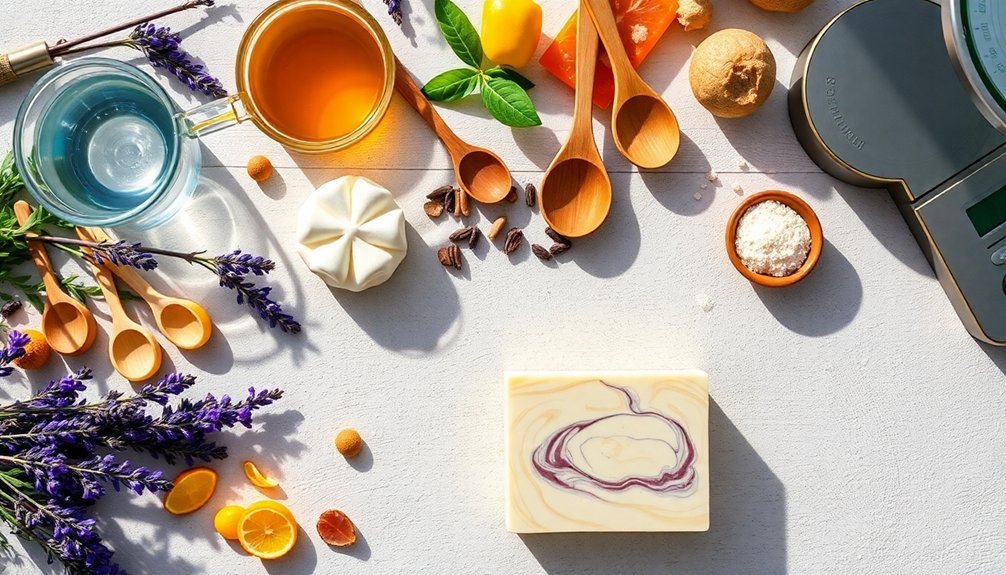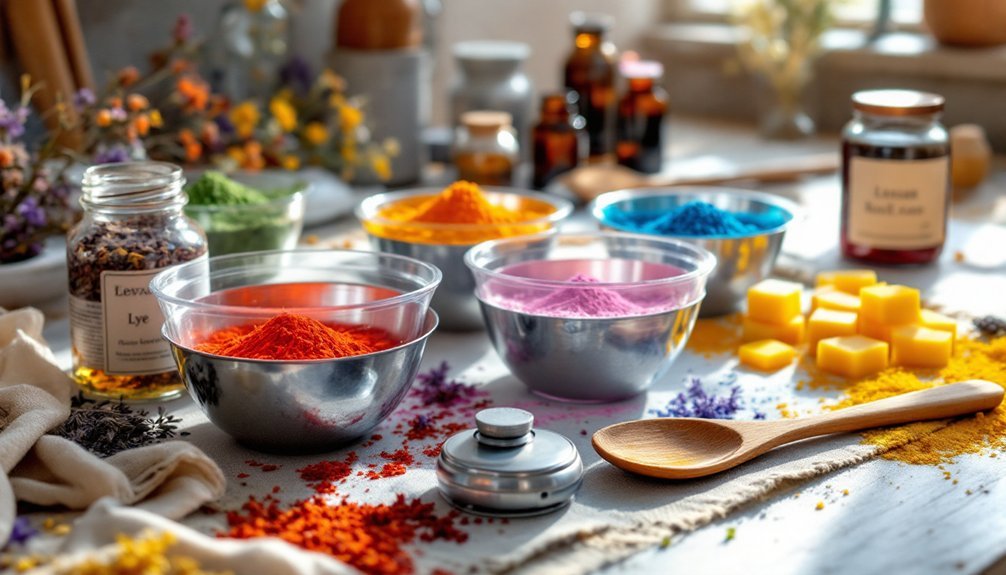Small-batch soap making is perfect for testing new recipes with minimal waste. Start with 4-8 ounces of oils using a balanced formula (50% olive/rice bran, 31% coconut, 6% castor, 13% hard butter). You'll need accurate digital scales, proper containers, and a quality stick blender. Always verify your measurements with a soap calculator and document your results for future refinements. The techniques you'll discover will transform your homemade soaps from simple experiments to professional-quality creations.
Small-Batch Crafting: Master Cold Process Production Tips

While experimenting with new soap recipes can feel challenging, starting with small batches offers the perfect solution for crafters.
Begin with just 4 or 8 ounces of oils for soapmaking to minimize waste while perfecting your technique.
Start small with 4-8 ounces of oils—just enough to experiment with your technique without wasting precious ingredients.
A standard small-batch recipe to make includes 8 oz (227g) of oils, 2.26 oz (64g) distilled water, and 1.13 oz (32g) lye solution.
Consider a balanced oil blend of olive/rice bran (50%), coconut (31%), castor (6%), and refined butter (13%).
Measure essential oil precisely—1/4 teaspoon for 4-ounce batches or 1/2 teaspoon for 8-ounce batches.
Use tall containers and keep your immersion blender fully submerged for effective mixing.
Don't forget documenting observations during curing, which helps track color and scent retention for improved future batches of soap.
Selecting the Optimal Test Batch Size
How much soap should you make when testing a new recipe? For cold process soap, aim for 4-8 ounces (1/4-1/2 pound) of oils. These smaller amounts let you experiment efficiently without wasting ingredients.
A standard test batch structure uses 8 oz (227g) of oils, 2.26 oz (64g) of distilled water, and 1.13 oz (32g) of sodium hydroxide.
Your oil composition should balance 50% olive or rice bran oil, 31% coconut oil, 6% castor oil, and 13% refined butter (shea, cocoa, or kokum).
When making soap in these small batches, add approximately 1/2 tsp of colorant or essential oil.
Keep detailed records of each test batch to refine your recipes over time. This methodical approach guarantees consistent results when you scale up production.
Balancing Oil Ratios for Consistent Results

Perfecting your small-batch soap requires more than just size—the oil ratios you choose will determine your soap's texture, lather, and moisturizing properties.
The artistry of soap lies not in quantity, but in the careful balance of oils that create your signature bar.
For balanced cold process soap making, aim for 50-60% hard oils and 40-50% soft oils in your formula.
A successful test recipe might include 50% olive oil, 31% coconut oil, 6% castor oil, and 13% hard butter.
When scaling batches up or down, make certain to recalculate water and lye proportions accordingly. For an 8 oz oil batch, you'll need approximately 2.26 oz of water and 1.13 oz of lye.
Adjust your superfat percentage (5-10%) based on desired moisturizing level, but maintain consistent oil ratios.
Always verify your formula with a soap calculator before proceeding to light trace—this guarantees your small batches deliver reliable results every time.
Essential Equipment for Small-Scale Production
Though crafting soap in small batches requires less equipment than commercial production, your success depends on having the right tools.
When making cold process soap, these essentials will elevate your soapmaking experience:
- Accurate digital scales with at least 5kg capacity – precise measurements are non-negotiable for consistent batches
- Tall, narrow containers for blending – keep your stick blender fully submerged during mixing to prevent unwanted air bubbles
- HDPE plastic containers for lye – protect yourself and your workspace by using proper storage for caustic ingredients
- Quality stick blender and thermometer – reduce blending time and monitor temperatures properly for perfect saponification every batch
Your small-batch cold process soap will shine with professional results when you invest in these fundamental tools.
Scaling Measurements Without Sacrificing Quality

Scaling recipes for small-batch soaping requires meticulous attention to proportions if you want professional results.
When making a single batch of soap at a smaller scale, always maintain the original ingredient ratios while adjusting your water and lye accordingly. For an 8-ounce soap base, use 2.26 ounces of distilled water and 1.13 ounces of lye for best results.
Your accurate measurements are non-negotiable when scaling down—invest in a reliable scale that measures to the tenth of an ounce or gram.
Utilize calculators like Soapee or Soapmakers Friend to verify your math, especially for superfat percentages. Document any adjustments you make based on personal preference, noting how changes affect the final product's quality.
This methodical approach guarantees your small batches maintain the same excellence as larger productions.
Frequently Asked Questions
What Is the Biggest Mistake First Time Soapmakers Make?
You'll likely make the critical mistake of imprecisely measuring lye and water. This careless approach leads to unsafe chemical reactions and poor-quality soap. Always use precise measurements to guarantee both safety and successful results.
What Not to Do When Making Soap?
When making soap, don't use shallow containers, measure ingredients inaccurately, add too many hard oils, use undissolved lye, or choose trace-accelerating fragrances. These mistakes can ruin your batch and compromise safety during production.
Why Is My Cold Process Soap Still Soft After 48 Hours?
Your soap is likely soft due to too many soft oils, insufficient lye concentration, excessive superfatting, or inadequate mixing. You should check your recipe's oil balance and verify you've reached proper trace during mixing.
Why Is My Cold Process Soap Not Getting Hard?
Your soap isn't hardening because you're likely using too many soft oils, not curing long enough, miscalculating lye, having high superfat levels, or storing in high humidity. Check these factors to troubleshoot the issue.
In Summary
When you've mastered these small-batch cold process techniques, you'll confidently produce premium soaps without wasteful experimentation. Your careful attention to batch sizes, oil ratios, equipment selection, and accurate scaling will transform your craft from hobby to consistent artistry. Don't rush the learning process—each small batch builds your skills and prepares you for larger production without compromising the quality that makes your soaps special.





Leave a Reply